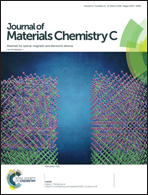Thermally activated delayed fluorescence material with aggregation-induced emission properties for highly efficient organic light-emitting diodes†
Abstract
Luminescent materials with aggregation-induced emission (AIE) properties exhibit high solid state emission, while thermally activated delayed fluorescence (TADF) materials can fully harvest singlet and triplet excitons to achieve efficient electroluminescence (EL). Herein, the amalgamation of AIE and TADF properties, termed aggregation-induced emission and thermally activated delayed fluorescence (AIE–TADF), is a promising strategy to design novel desirable luminescent materials. In this paper, a new tailor-made material, DCPDAPM, is obtained based on carbazole as the skeleton, 9,9-dimethyl-9,10-dihydroacridine as the donor group and benzophenone as the acceptor group. Its structure is fully characterized by elemental analysis, NMR spectroscopy and mass spectrometry. Furthermore, its thermal stability, photophysical properties, and electrochemical properties are investigated systematically. The results show that this AIE–TADF compound exhibits good thermal stability, electrochemical stability and AIE and TADF properties. Ultimately, using DCPDAPM and DCPDAPM doped into CBP as light-emitting layers, a non-doped OLED (device A) and doped OLEDs (device B, device C and device D) were fabricated and studied. Device A displays green light with a turn-on voltage of 3.2 V, a maximum brightness of 123 371 cd m−2, a maximum current efficiency of 26.88 cd A−1, a maximum power efficiency of 15.63 lm W−1 and an external quantum efficiency of 8.15%. Among the doped OLEDs (device B, device C and device D), device D shows the best EL performance with a turn-on voltage of 3.6 V, a maximum brightness of 116 100 cd m−2, a maximum current efficiency of 61.83 cd A−1, a maximum power efficiency of 40.45 lm W−1 and an external quantum efficiency of 19.67%. These results adequately demonstrate the practicability of combining AIE and TADF to explore new efficient emitters.



 Please wait while we load your content...
Please wait while we load your content...